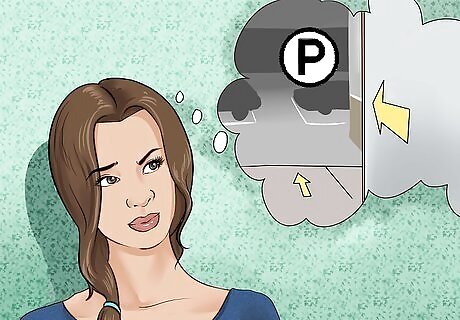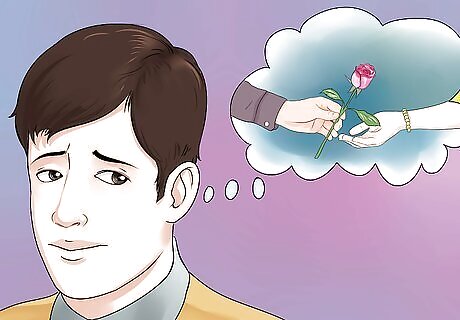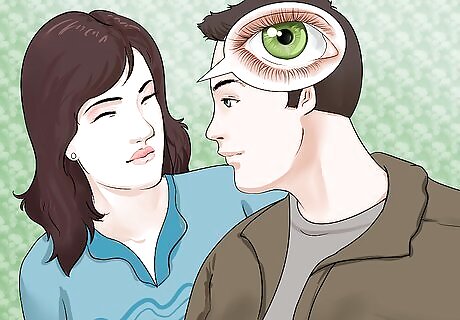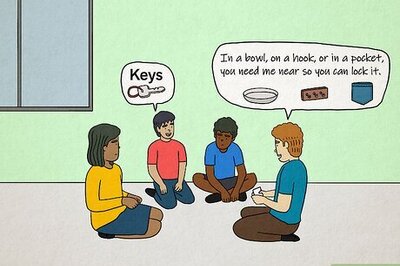
views
Setting the Scene

Choose who is going to be kissing whom. Maybe you have two characters that have been circling each other for a long period of time, or two characters who suddenly realize their feelings for each other. Regardless, it’s important to isolate which two characters in your story are going to pucker up so you can shift the point of view of the story to them. Keep in mind you don’t necessarily have to have two people kissing each other, as it could be multiple characters kissing each other or one person kissing themselves in the mirror. In any event, it's a good idea to identify the characters in the kissing scene.

Determine where the kiss is going to take place. The setting for the kiss is important because the setting will inform the mood of the kiss. In writing, mood is a literary element that evokes certain feelings or vibes in your audience through words and descriptions. Think of it as the atmosphere your characters are moving around in or kissing in. By figuring out the setting of the kiss, you can create a lot of implied meaning. The setting will help you establish a certain mood or atmosphere, and you can show your audience a certain mood, as opposed to telling them. For example, a kiss in a dark empty parking lot has a completely different mood or atmosphere than a kiss at a party. One setting implies a more intimate mood and one setting implies a more exposed or open mood.

Think about how the kiss is going to take place. Are your characters going to be alone or surrounded by others? Is one character going to be more aggressive or eager for a kiss in the scene? Will both characters know the kiss is coming or be completely surprised by it? This is a good moment to also think about how your characters are going to be positioned in the scene. Maybe one person is going to be standing beside someone else in a room. Or maybe both characters are going to be sitting side by side. Think about the physical presence of your characters and how they are going to move around in the kissing scene.

Consider why the kiss is taking place. This is really a chance for you to think about the motivations of your characters and why they would end up kissing each other. If they hate each other throughout the story but suddenly end up in a deep, sensual kiss, this may not be very believable for the reader. Re-evaluate how and why you have reached this point in the story where the characters are in a kissing scene. Did you establish their relationship well in the early stages of the story, so a kiss between them makes sense? And if you are going for the element of surprise, ask yourself if you created enough character details so the kiss will throw readers off guard but will not throw them out of the story.
Creating a Build Up

Build on established conflicts between the characters. While it may be tempting to just throw two characters together into a locked room or dark cave, where they will eventually resort to a kiss, a more effective technique is to use past conflicts or ongoing conflicts between the characters to create a convincing build up to the kiss. This could be a past love that reappears in a character’s life or a previous scene where one character sees another character do something that they find attractive or compelling. Remember, a kiss is usually an indication of desire, so make sure your characters desire each other, if only for a moment, to make the kiss seem believable. Don’t neglect all the hard work you’ve put into building up your characters. Instead, use characterization to your advantage and build off of previous conflicts or scenes to create build up.

Put both characters within close proximity of each other. Now that you’ve established how a past conflict has led both characters to consider kissing each other, it’s important to place both characters within kissing distance. You can do this by having two characters accidentally bump into each other, or have one character plan to run into another character. There are many ways you can move your characters physically so they are in a setting and mood that feels appropriate for a kiss, but the point is to get them close to each other. Focus on the body movements of your characters. A quick, fast move towards each other will likely indicate intense longing or desire, and a slower, more labored move towards each other will likely indicate a more unsteady or unsure passion between the characters.

Have one character notice something new or interesting about another character. Because you now have your characters within kissing distance, they have the opportunity to notice small details on the person’s face or neck. Your characters are seeing each other in a new, intimate way, so reflect this by including physical descriptions of something not noticed before. For example, your character could notice the other character has a speck of green in their eyes, a freckle on their nose, or a small birthmark on their neck.
Describing the Kiss

Use the five senses. Rather than simply throw out a whole bunch of adjectives to describe the kiss, focus instead on how the kiss is affecting your character’s sense of sight, sound, smell, touch, and taste. This will make the descriptions feel specific to your character’s point of view and ensure you are hitting all the sensual aspects of the kiss. Sight is probably one of the easiest senses to describe; simply write what the character is seeing during the kiss. Sound could mean background noise like music at a party or the character’s loud, excited heartbeats. Depending on the duration of the kiss, you could also include soft moans or other noises of pleasure (or disgust), as appropriate to your character. Smell could be what your character smells in the air or on the other person as they kiss them, such as perfume, cologne, or a natural scent. Touch is a very important aspect to describing a kiss. Focus on tactile details like how the character’s skin feels and how their lips feel. Taste can be broad or very specific when describing a kiss. Keep in mind describing a kiss as sweet implies it was enjoyable and describing a kiss as sour or bitter implies it may not have been enjoyable at all.

Use body language. Think about how your characters are moving their bodies as they kiss. Body language will also let your audience know how the characters are responding emotionally to the kiss. A physical reaction like pulling or pushing away from the kiss will imply different emotion than a physical reaction like falling or relenting to the kiss. The easiest way to use body language in the scene is to focus on the movements of specific body parts: Lips: perhaps the most important physical detail in a kissing scene, focus on the texture of the character’s lips or how they feel against another character’s lips. Tongue: another very important physical detail in a kissing scene that can indicate aggressive desire (lots of tongue) or unsure, gentle desire (no tongue). Think about what type of kiss you’re trying to convey and include or do not include tongue descriptions accordingly. Heads: most people tilt their head to one side when they kiss. Of course, if you’re going for a more awkward kiss, it may be beneficial to have a moment of bumping foreheads. Eyes: are your characters’ eyes opened or closed? Open eyes usually indicates a surprised reaction or a detached reaction. Consider the emotions of your characters and decide from there. Noses: keep in mind that though your characters may tilt their heads when they kiss, their noses will likely still brush against each other or against the side of their faces. Hands and arms: during the kiss, a character’s hands could be up in the air (usually indicating an unwelcome or surprised kiss) or wrapped around the character’s body (usually an indication of an enjoyable kiss). They could also run their fingers through a character’s hair, hold the back of their head, rub their lower back, etc.

Discuss how the kiss ends. Your characters can’t lock lips forever! Somehow, one character or both characters have to pull away from each other, or be interrupted and be forced to pull away from each other. If the kiss happens early in your story, you will likely need another conflict to arise to complicate the kiss and create enough tension to keep your audience interested. If the kiss happens towards the end of your story, think about how your characters might feel after the kiss and how the kiss affects their emotions towards the other character.


















Comments
0 comment